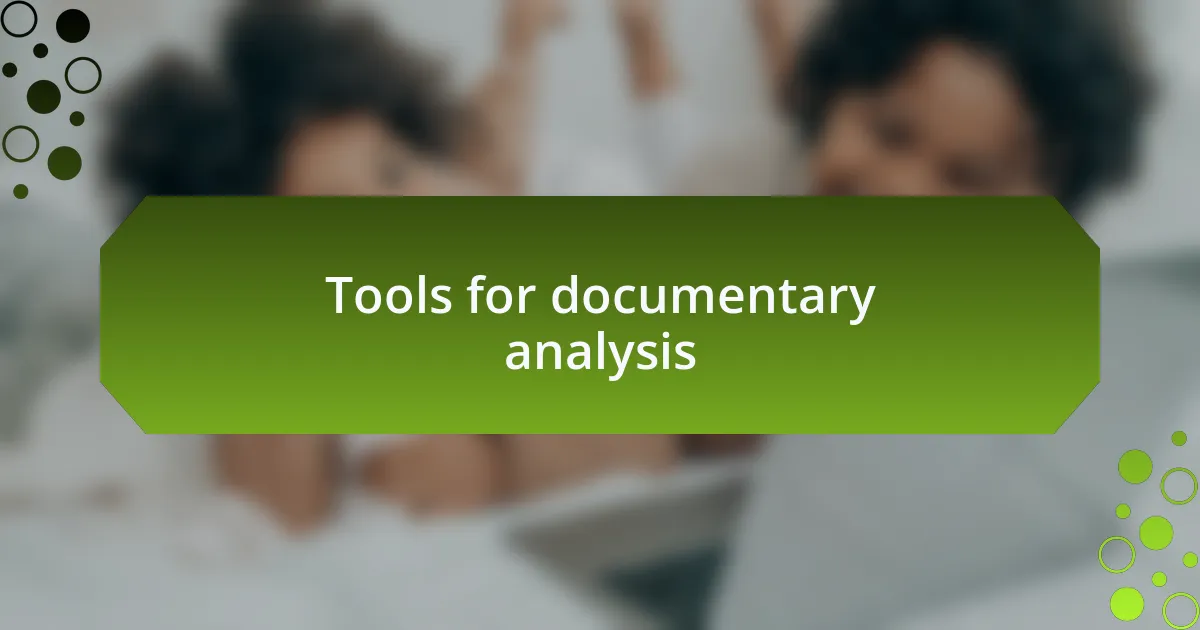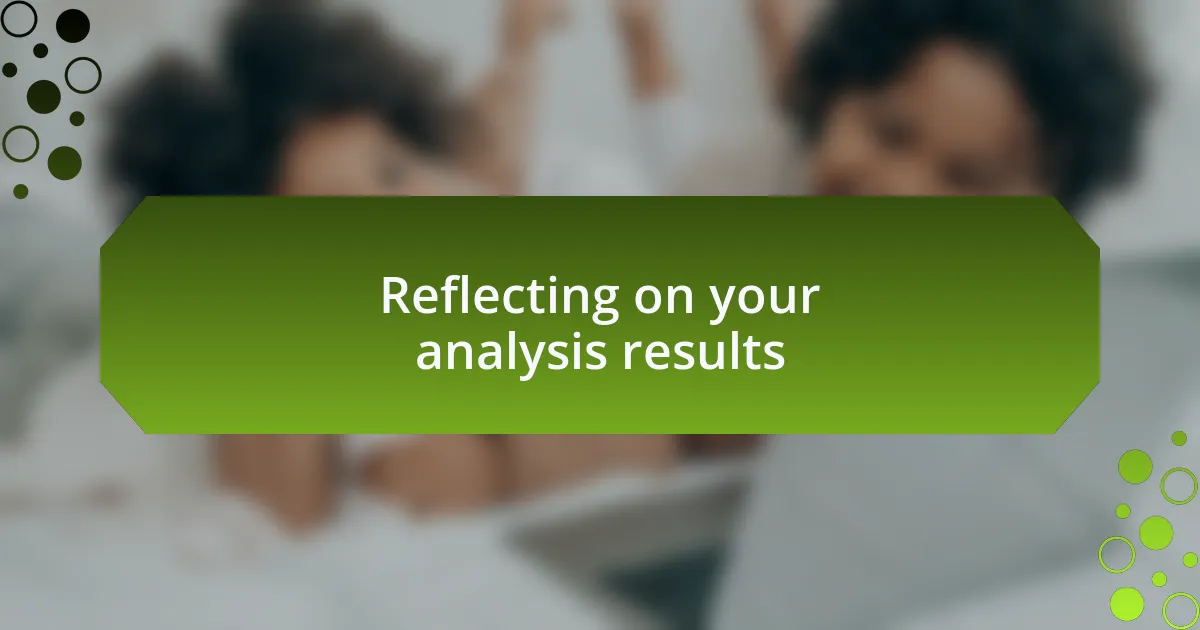Key takeaways:
- Understanding the filmmaker’s intentions and choices enhances the analysis of documentaries, revealing deeper narratives and biases.
- Engaging with the documentary’s structure, visuals, and diverse perspectives fosters critical thinking and personal reflection.
- Utilizing tools like note-taking apps and thematic checklists can improve the analytical process and deepen emotional connections with the film.
- Post-viewing reflection and discussions with others enrich the understanding and interpretation of documentary content.

Understanding documentary analysis
When analyzing documentaries, I find that it’s essential to understand the intentions behind the filmmaker’s choices. Why did they choose this particular subject? Reflecting on this often reveals deeper narratives and insights that might not be immediately apparent. For instance, when I watched a documentary on climate change, I was struck by the emotional stories of those affected—these personal testimonies resonated with me more than raw statistics ever could.
As I analyze a documentary, I pay close attention to its structure and style. The way information is presented can profoundly impact how the audience receives the message. I remember a documentary about urban homelessness that effectively used stark visuals and raw storytelling. It left me feeling unsettled yet compelled to think critically about society’s role in these issues. How does the documentary’s format shape your understanding of the topic?
Another aspect I consider is the balance of perspective offered in the film. Are different viewpoints presented, or is it heavily biased? I once watched a documentary that focused solely on one narrative, and it made me realize how important it is to explore multiple angles to gain a comprehensive understanding. This encourages me to ask: what voices are missing, and how does that affect my interpretation?

Importance of analyzing documentaries
Analyzing documentaries is crucial because it allows viewers to engage more deeply with the subject matter. When I dissect a film, I often discover layers of storytelling that enhance my understanding and empathy. For example, after watching a documentary on food scarcity, I found myself reflecting on my own eating habits and the privilege of having access to food. This personal connection moved me to think more about my role in the broader narrative.
Moreover, delving into the filmmaker’s motivations can reveal biases that inform the message being conveyed. While viewing a documentary about a controversial political figure, I realized the importance of questioning what was left unsaid. I began to wonder, were there alternative views that could change my perspective? This realization emphasizes that analysis not only enriches our understanding but also challenges us to think critically about the information being presented.
Lastly, the act of analyzing can foster a sense of responsibility to seek out additional information and diverse viewpoints. After watching a documentary on environmental activism, I felt compelled to educate myself further. I couldn’t help but ask, how can I contribute positively to these issues? It became clear to me that informed viewers are empowered to drive change, bridging the gap between entertainment and activism.

Steps to effectively analyze documentaries
When I first sit down to analyze a documentary, the first step I take is to engage with the film’s central thesis. I reflect on the main argument or message the filmmaker is trying to convey. For instance, while watching a documentary about climate change, I found it essential to identify the filmmaker’s stance. What are they urging us to understand, and why does it matter? This kind of critical reflection can set the foundation for deeper analysis.
Next, I pay attention to the visuals and narrative structure. Often, I find that the choice of images and the way the story unfolds can heavily influence my emotional reaction. In one documentary on social justice, the filmmaker used stark, contrasting visuals to highlight disparities. This not only evoked a sense of urgency but also helped me connect more profoundly with the subjects. Have you noticed how certain visuals stick with you long after watching? Analyzing these elements can reveal much about the filmmaker’s intent.
Finally, I take the time to assess the sources and interviews presented. Understanding who is featured and their backgrounds can offer invaluable context. For example, when I watched a documentary on historical events, I was surprised to learn that many voices presented were not the expected experts but rather everyday people impacted by the events. This shifted my perspective and made me question who gets to tell the story. Are the voices represented comprehensive and diverse? This inquiry drives home the importance of recognizing bias and encourages me to seek out further information.

Tools for documentary analysis
When it comes to analyzing documentaries, I find that having a good set of tools can make a world of difference. For instance, I often rely on note-taking apps to jot down key points as I watch. This method helps me capture my immediate thoughts and emotions, allowing me to revisit them later for deeper reflection. Have you ever paused a documentary just to write down what you felt? It’s an invaluable way to keep track of those fleeting ideas that can otherwise slip away.
Additionally, I utilize online platforms and forums to compare my insights with others. Engaging in discussions about a documentary can reveal interpretations I might not have considered. I remember once participating in a chat about a documentary on mental health, where diverse viewpoints enriched my understanding. It made me realize how collaborative analysis can uncover layers within the film that I might have missed on my own.
Finally, using thematic checklists can heighten my analytical process. Creating a simple list of themes or motifs I expect to track during the viewing can sharpen my focus. For example, while analyzing a documentary about migration, I developed a checklist that included themes of identity, struggle, and resilience. This proactive approach not only kept me engaged but also sparked a deeper emotional response as I recognized how each theme intertwined with the narratives presented. Have you tried something similar? It can resonate on a personal level, making the viewing experience much more impactful.

Personal techniques for deeper analysis
One technique I find particularly effective is to create a mind map while watching. This method allows me to visualize connections between ideas and themes as they unfold in real-time. I remember when I watched a documentary on climate change; sketching out key concepts helped me see how various factors intertwined, making the complex subject much easier to digest. Have you ever tried mapping your thoughts? It can transform your understanding of a film.
I also pay close attention to the documentary’s cinematography and sound design. These elements often communicate emotions and themes that words alone cannot convey. For example, during a documentary on indigenous cultures, the use of traditional music alongside stunning visuals evoked a profound sense of place and identity for me. It got me thinking—how do audio and visual elements impact your emotional connection to a story?
Another technique involves revisiting favorite documentaries after a few months or years. It’s fascinating how my perspectives can shift based on life experiences. The last time I rewatched a documentary on social justice, I found new layers of meaning that mirrored changes in my own understanding of advocacy. Have you experienced something similar? Reflecting on how your insights evolve can be a rewarding path to deeper analysis.

Reflecting on your analysis results
Once I’ve completed my analysis, I take time to reflect on the insights I’ve gathered. It can be enlightening to jot down my thoughts right after watching, capturing that fresh perspective. I remember finishing a documentary about mental health; writing down my reactions prompted me to consider how stigma affects our understanding of these issues in everyday life. How often do we pause to absorb what we’ve learned after viewing?
I find it crucial to revisit my notes a few days later. This practice helps me identify recurring themes and questions that emerged from my initial viewing. After analyzing a film on technological advancements, I noticed how my thoughts about innovation versus ethical responsibility continued to evolve. Have you revisited your own reflections to compare how they’ve changed over time?
Additionally, discussing my findings with others has proven invaluable. I recall a conversation with a friend after watching a documentary on immigration; she brought up perspectives I hadn’t considered. This dialogue not only deepened my understanding but also highlighted how varied interpretations can enrich the experience. How do conversations shape your own analysis of documentaries?